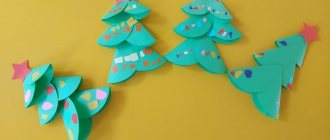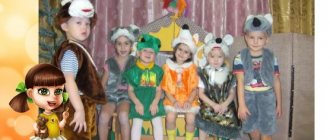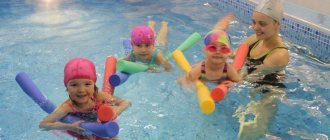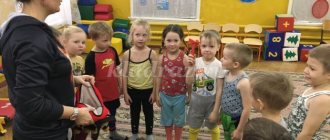Club work in the senior group of kindergarten: goals and principles of organization
Club work in preschool educational institutions (DOU) is a form of additional education, the main goal of which is the development of the individual creative abilities of each child. A developmental circle is a bringing together of children based on their desires and interests to obtain deeper, expanded knowledge in one of the educational fields. There are also correctional circles that are designed to facilitate the perception of program material by children with developmental disabilities and disabilities (speech therapy, for children with impaired posture, vision, hearing, etc.). The organization of clubs in kindergarten complies with all the principles of preschool education enshrined in the Federal State Standard (FSES):
- supporting childhood diversity;
- preserving the uniqueness and intrinsic value of preschool childhood as an important stage in the overall development of a person; full-fledged living by a child of all stages of preschool childhood, amplification (enrichment) of child development;
- creating a favorable social situation for the development of each child in accordance with his age and individual characteristics and inclinations;
- assistance and cooperation between children and adults in the process of children's development and their interaction with people, culture and the world around them;
- introducing children to sociocultural norms, traditions of the family, society and state;
- formation of cognitive interests and cognitive actions of the child through his inclusion in various types of activities;
- taking into account the ethnocultural and social situation of children's development.
In addition, when organizing a circle, you must consider:
- Children's interests. The selection of children for the club is carried out on the basis of the teacher’s monitoring of the pupils’ interests and hobbies. In the older group, this is especially important, since children at this age are quite independent, generally formed individuals. They already have strong preferences, demand respect for themselves, and react negatively to violations of personal space. At the same time, a teacher who shows interest in their lives and is able to express his understanding of children's problems and hobbies becomes an authority for older preschoolers.
- Parents' wishes. To implement this requirement, surveys and questionnaires are conducted among parents of pupils, the analysis of which makes it possible to adjust the direction of additional educational work in preschool educational institutions. The work of the teacher with parents is very important in this regard. Some mothers and fathers believe that their child should attend several clubs and sections, and immediately enroll the child in choreography, English, drawing, and swimming. Such accelerated development is unlikely to bring positive results, even if the child willingly attends all the clubs at first. However, fatigue still accumulates and can result in an emotional outburst (crying, screaming, sudden refusal of normal activities, performing routine tasks) or even aggression towards younger brothers and sisters who do not need to go to clubs, therefore, they are in a more advantageous position, in the child’s opinion. The teacher needs to conduct explanatory work with such parents, emphasizing that the physical and mental health of the baby should always be in the foreground. The maximum number of clubs and sections recommended by psychologists and doctors for older children: two per week, with different directions (drawing and gymnastics, English and dancing).
- The second extreme that parents sometimes go to is choosing a circle of their own free will, regardless of the child’s abilities and wishes. Here, the painstaking and patient work of the teacher is also necessary: you can “open your eyes” to the child’s talents by showing drawings and crafts, and if a preschooler, for example, has a craving for mathematics and a desire to study it in more depth, then the child’s extensive knowledge in this area can be demonstrate in dialogue with him using some math quiz questions.
Excessive workload of a preschooler with clubs leads to the development of fatigue and stress, decreased mood and performance
- curious people who are interested in the world of objects, numbers and numbers, nature;
Club classes are held during hours intended for independent activity of children in a group; they are not allowed to be organized during walks, naps, or direct educational activities.
A class of choreography and theatrical performance is incomplete without costumes and scenery.
- social and personal (local history, patriotic, according to traffic rules);
Comprehensive program
The circle, which uses an integrated approach to the development of a creative personality, has a slightly different thematic plan. This could be a rehearsal plan for preparing a performance, joint production of props and scenery, etc. The teacher himself determines the number of hours required for the educational process.
The name of the arts and crafts club of the comprehensive program is not an easy choice. Different types of art met here; combining them into one is a serious task. It seems most appropriate to start from the idea of theater. Since the theater contains all types of visual art, the following options can be offered:
- "Globe".
- “PUPS” (“Let laughter help learning”).
- "Harlequin".
- "Pinocchio."
- "Cipollino".
Thematic classes use musical compositions, paintings, songs and other types of work with children. The decorative and applied component can be expressed in the production of props.
Tasks of circle work
The tasks of general development circles, first of all, depend on the educational field and type of activity chosen by the teacher. The goals and objectives of the circle work are indicated in the circle program: general - in the target part, specific - in the work plan for each lesson separately.
Table: planning the work of the “School for Young Book Lover” circle, developed by A. N. Pimenova
| Purpose of the program |
| |
| Program objectives |
| |
| Methods of working with the book |
| |
| Long-term work plan for the circle (fragment) | ||
| Month | Lesson topic | Lesson objectives |
| September | "Excursion to the children's library." Getting to know the reading room, the librarian, and his work. | Find out how books live, arouse interest in them. |
| Conversation "Her Majesty's Book". | Arouse interest in reading fiction. Reveal the role of books in people's lives, show the importance of books and reading for the formation of children's intellectual and creative abilities. | |
| Conversation “The fairy tale is rich in wisdom.” Reading the Russian folk tale “Sister Alyonushka and Brother Ivanushka” | Introduce children to the variety of Russian folk tales. Enrich children's reading experience with works of a more complex genre (fairy tales). Provide the ability to tell a fairy tale from the perspective of a literary character. | |
| Getting to know the works of A.S. Pushkin. Reading poems about autumn. | Introduce children to the biography and work of the poet. Cultivate sensitivity to the artistic word. Arouse interest in the poet’s work, a desire to listen to his works. | |
| October | Conversation “Where the book came from” | Give a basic idea of how books are created. |
| Group visit to the mini-museum of books. Excursion “Books of our grandmothers”. | Give children an idea of what books looked like in the last century, what kind of illustrations they had. | |
| Competition "Let's bring our fairy tales to life." | Learn to note the features of a fairy tale, understand the motives of the heroes’ actions, learn to transform, developing intonation expressiveness. | |
| Acquaintance with the work of N. Nosov. Reading the story “The Living Hat.” | Introduce children to the work of the writer N. Nosov. Contribute to the formation of an emotional attitude towards a literary work. | |
| November | Celebration of “Dedication to Readers”. | To help little listeners become readers, to instill interest, love, and respect for the book as a source of new interesting information. |
| "Journey through the Russian Fair" | Introduce children to various genres of oral folk art. Arouse interest in folklore. | |
| Acquaintance with the work of Yu. Vasnetsov. Productive activity: drawing “Favorite fairy tale characters.” | Expand your understanding of the work of an artist - an illustrator of children's books. | |
| “Miracle Tree” - quiz. | Consolidate knowledge about the works of K.I. Chukovsky. | |
| Quote By: | https://nsportal.ru/detskiy-sad/raznoe/2015/03/30/programma-kruzhka-dlya-detey-starshey-gruppy-detskogo-sada-shkola | |
Organization of circle work in the senior group of preschool educational institutions
Like all activities in a preschool educational institution, the work of the circle has a regulatory framework and requires the teacher-leader to clearly maintain documentation.
Senior group documentation
Organizing circle work involves studying the following regulatory documents:
- charter and educational program of the preschool educational institution;
- regulations on additional educational activities of a preschool institution.
Based on the needs of the children and the results of the children’s assimilation of the general educational program, the teacher draws up a program and work plan for the circle for the year. Mandatory sections of the circle's work program:
- An explanatory note that reveals the relevance of additional education in the chosen field.
- Goals and objectives of the circle.
- Methods and techniques of work.
- Expected results of working with children.
- Methods and methods of diagnosis.
- List of used methodological literature.
Planning the work of the circle includes:
- subject of classes for the year;
- objectives of each lesson;
- a brief description of work methods (didactic game, conversation, experience, etc.), techniques for performing work (for arts and crafts and manual labor);
- dates of classes.
In addition, the circle leader keeps a log of class attendance. At the beginning and end of the school year, he also fills out diagnostic cards for each child attending the circle in order to see the dynamics of the students’ development in the chosen educational area.
Forms of organization of circle work
The most interesting forms of organizing work with children that make it possible to implement the program objectives of the circle are:
- Frontal (with the whole group) indoor lesson. Usually, children gain new knowledge and master new skills there.
- Classes carried out at the preschool educational institution site. This could be search and research activities in a flower garden, vegetable garden, or ecological trail (for a natural history group). Sports section classes can also be held in the fresh air, which will bring additional benefits to the health of the students.
- Entertainment, leisure, competitions and quizzes, which can take place in a music or sports hall, with the invitation of parents or children of other groups as spectators.
- Activities outside the preschool educational institution (excursions, themed walks). They are used to consolidate acquired knowledge, enrich children's experience with new impressions of objects and phenomena that cannot be displayed in a kindergarten setting (library, local history museum, park, cultural monuments).
If children enjoy participating in a club, they will fully reveal their talents.
Work with colleagues in a preschool institution is carried out in the form of master classes, consultations, and round tables, at which each teacher can both express his opinion and ask for advice from colleagues.
We should not forget about working with the students’ parents. The head of the circle can show the results of current activities by organizing an exhibition of children's works, a speech at a parent meeting, a photo exhibition based on the results of an excursion, visiting memorable places in the city, or photographing the kids at work during a circle class.
The photo report on the activities of the circle will be of great interest to parents.
Structure and time plan of the circle lesson
Club classes are held in the senior group once a week in the afternoon; their duration should not be longer than the duration of organized educational activities for a given age according to SanPiN (20–25 minutes). Children are divided into subgroups of no more than 12–15 people.
The structure of a circle lesson does not differ from the traditional structure of educational activities:
- Introductory part. Organizing the children, communicating the topic of the lesson, drawing attention to the topic by looking at equipment for the experiment, costumes for theatrical performance, and a beautiful craft to be made. 2–3 min. min.
- Main part. Motivation for artistic and cognitive activities. Games, conversations, practical, independent, creative activities of children. There are no strict requirements for conducting the main part of the circle’s lesson; each teacher conceives and carries out the work, ensuring that the tasks of the lesson are completed, according to his creative plans and capabilities. The only requirement: children must receive positive emotions and joy at the same time as benefiting their development. Up to 15 min.
- Final part. Summing up, analyzing activities (briefly). If children have learned new information or mastered a new skill, it is worth emphasizing this so that preschoolers see the club activities as not just an enjoyable, but also a useful pastime. 1–2 min.
When organizing a circle class, one should not forget other sanitary and hygienic requirements (change of activities, physical education breaks, minutes of psychological relaxation, inadmissibility of using dangerous equipment and materials). Since during club classes children often receive information that goes beyond the scope of the program, more expanded and in-depth, gaming techniques that help relieve fatigue and clearly explain complex things to children are becoming especially relevant.
Children's work with unsafe objects (needle, scissors) should be carried out under the strict supervision of the teacher
Table: examples of the motivational stage in group work classes with children of senior preschool age
| Topic and author of the lesson | Technique used | Contents of the stage |
| Club lesson “Watercolor” Topic: “Dandelions have blossomed”, teacher Gritsenko N.V. | Literary word, conversation. | Educator: - Spring has finally come into its own, and no matter how angry winter is, its time is over. Spring is often called the blooming time. Why do you think? (Children's answers). The sun came out. The first flowers appeared. What are their names? (snowdrops, dandelions, tulips, daffodils, mimosas). What flowers grow in our area? (dandelions). Listen to O. Vysotskaya's poem.
- How is this flower similar to the sun? (round, yellow) . — In the old days, people said: “The golden dandelion is the sun’s dear son!” " The buzz of a bee sounds. — Grandma Bee has arrived. She is preparing for the holiday, she needs to treat all her guests to tea with honey. Only the honey has run out over the winter. Where can she get a new one? (from flowers). Bees love to fly to dandelions, they drink sweet dandelion nectar and make dandelion honey - thick and fragrant. How can we help our guest if there are no dandelions in our group, but there are brushes and paints? (draw). Quote from: https://colobocmdou4.ucoz.ru/load/konspekty_nod/konspekt_zanjatija_po_kruzhkovoj_rabote_akvarelka_tema_rascveli_oduvanchiki/4–1-0–82 |
| Theater group lesson “In the world of fairy tales”. Topic “Profession of an actor”, author Egorova I.G. | The appearance of a fairy-tale character, a mimic game, a study on changing the timbre of a voice. | Musical director: - Hello, my dears! I'm glad to see you! Today we will have an unusual activity. The Theater Fairy has come to us, here she is! (Shows the doll) Together with her we will talk about the theater and try to become actors ourselves. (Places the doll on the table) - And now we’ll say hello to you. The mimic game “Give a smile to your neighbor” is played (in a circle). — People who play in the theater are called artists. Becoming an artist or actor is very difficult. It is necessary to master facial expressions - using facial expressions to convey the hero’s mood, reaction to an event, real or imaginary. A good actor must master not only facial expressions, but also gestures—hand and head movements. Let's try to learn how to change our voice depending on the mood and character of the hero we are portraying. Study on changing the timbre of the voice: - Pussy, what is your name? - Meow! (gently) - Are you guarding the mouse here? - Meow! (affirmative0. - Pussy, do you want milk? - Meow! (with great pleasure) - And a puppy as a companion? - Meow! Fff-rrrr! (portray in different ways: cowardly, scared, indignant). Quoted from: https:/ /www.pedmasterstvo.ru/categories/29/articles/418 |
| Lesson of the “Literacy” club. Theme “Travel to Africa”, author Gainanova V.Z. | An invitation to travel, asking a riddle. | Educator: - Guys, you traveled a lot during classes to get acquainted with the outside world in different countries and continents. Today we will also go on a trip. But where? Find out by solving the riddle:
Quote from: https://docplayer.ru/32619099-Konspekt-zanyatiya-kruzhka-gramotey-ka-starshaya-gruppa.html |
Table; lesson notes for the “Theater and Children” club in the senior group on the topic “Playing theatre,” author S. V. Sologubova
| Lesson stage | Contents of the stage |
| Tasks |
|
| Introductory part | Educator: - Guys, look at the obstacle in front of us at the entrance - there are planks. To get into a fairy tale, you need to put together a path of fabulous, magical words and expressions from famous fairy tales. Children call fairy tale words - they lived, they were; in some kingdom; at the behest of the pike, at my will; fly, fly petal; this is the end of the fairy tales, etc. d. “Greeting game” Take each other’s hands. I ask you to stand in a circle and start the greeting game.
Educator: - Guys, today we have an unusual, magical activity, but do you know who the artists are? (Children's answers). Today we will try to become real artists. Many of you dream of becoming one and love to perform, and today we will find out what you need to be able to do to become artists. Make yourself comfortable. (children sit down). |
| Main part | Teacher: (takes out a letter and reads): “Hello guys! If you are reading this letter, it means that you have encountered the first obstacle that we have come up with for you, we have heard that you want to become an artist, but for this you must pass several tasks - tests. The assignment is in an envelope. See you soon. Children of the theater studio “Vesely Balaganchik” Teacher: (takes assignments out of the envelope and reads) Task 1. “Theater professions. What's behind the door? Teacher: - Guys, there are cards in front of you. What theatrical profession do these images belong to, who works behind this door, what do they do in the theater?
Task 2. The teacher reads.
You will have to show the hero using gestures and movements. Sketches:
Task 3. Breathing and speech warm-up “Echo”.
|
| Final part | Educator: - Guys, you did a great job with all the tasks, which means you are real artists and are ready for our rehearsal and then show the kids the fairy tale “Turnip”. Choose the hero you will play, put on costumes. Is everyone ready? (Children show the fairy tale “Turnip”). |
| Quote from: https://nsportal.ru/detskiy-sad/raznoe/2016/09/13/konspekt-zanyatiya-kruzhka-teatr-i-deti-v-starshey-gruppe-igraem-v | |
Senior group. Senior preschool age. Children 5-6 years old
Master class on the application “Christmas tree from paper circles” for children of senior preschool age
Objectives: - expand ideas about winter, the New Year holiday, the Christmas tree as a symbol of celebrating the New Year; — improve technical skills and skills in working with paper ; - strengthen the skills of folding paper and using scissors correctly; - develop creative...
Long-term plan for group work on FEMP with children of older and preparatory age SEPTEMBER 1) “Help Cheburashka”
, Purpose: To train children in grouping geometric shapes.
Develop observation, attention, memory. Developmental environment: a set of logical blocks; toy "Cheburashka
"
2) "Labyrinth". Goal: To teach children to “read”
signs-symbols (signs...






